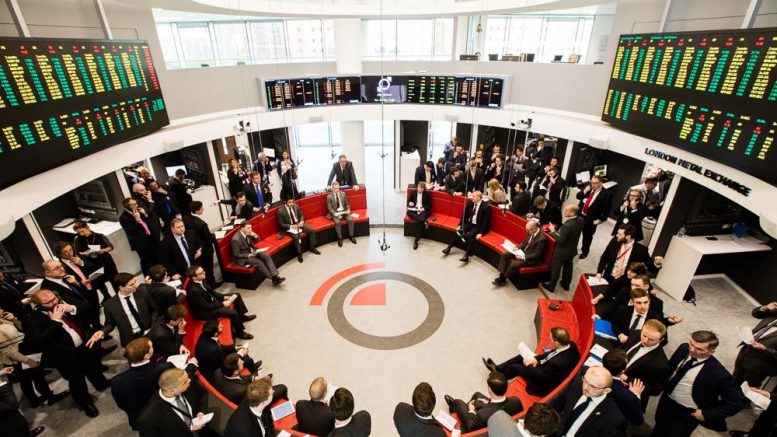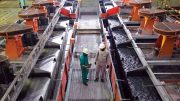VANCOUVER — The annual gathering of London Metal Exchange (LME) Week provides a bellwether for the major trends in base metals and industrial mineral markets over the coming year.
Metal investors, producers and consumers descended on London in early November to discuss emerging themes that include: impending copper and nickel deficits, expanding electric vehicle markets and environmental protection in China.
According to Colin Hamilton, managing director of commodities at BMO Capital Markets, copper and nickel dominated many discussions.
Copper has been topical over the past six months, as three-month future contracts gained 20% en route to a US$3.10 per lb. close at press time.
For copper, the bullish investment thesis combines declining head grades at major operations, a lack of modern exploration investment and a limited selection of viable development projects at current prices.
There’s dispute, however, over the timing of any pending copper supply deficit, and its effect on prices.

Mill under construction at First Quantum Minerals’ Cobre Panama copper project in Panama. Credit: First Quantum Minerals.
Hamilton noted that Freeport-McMoRan’s (NYSE: FCX) large Grasberg copper-gold operation in Indonesia is expected to hit peak production next year, while First Quantum Minerals’ (TSX: FM) Cobre Panama copper operation, labelled the “last greenfield megaproject,” is scheduled to come online.
BMO Research said there is “general agreement that the copper market will once more be roughly balanced next year,” and that no one is forecasting copper prices above US$3.18 per lb. for next year.
“Looking into 2018, we actually estimate copper has the weakest fundamentals out of all the industrial metals. It doesn’t have a great story in 2018,” added Natasha Kaneva, a metals analyst with J.P. Morgan, during a base metals panel.
“We’ll see that last wave of mine projects coming onstream, and at the same time we believe the global demand will be maintained around current levels. Since we’re seeing a big supply response from the mine sites we expect another surplus,” she said, noting that copper could become a much bigger story during the second half of 2019.
Meanwhile, Hamilton said “investor interest was clearly piqued by nickel” after positive comments about nickel by majors Vale (NYSE: VALE), Glencore (LON: GLEN) and BHP Billiton (NYSE: BHP; LON: BLT).

The base metal debate at LME Week in November 2018. Credit: London Metals Exchange.
Three-month contracts for nickel have gained 27% since early June and closed at US$5.15 per lb. at press time. The metal price has benefitted from growing demand related to the rise of electric vehicles — similar to rallies in the lithium and cobalt markets.
“Every presentation we saw had a section on electric vehicles and a shift in battery technology towards more nickel-intensive cathodes, the clear topic du jour,” Hamilton noted.
BMO Research argued “nickel fundamentals actually weakened” recently, after a rise in Indonesian ore export licences and the prospect of 8% growth in global supply next year.
Kaneva added that nickel could stand to benefit the most from recent environmental restrictions by Chinese regulators.
Guy Wolf, global head of market analytics at commodity broker Marex Spectron, said “it’s great that people are excited about electric vehicles again, but if you look at the percentages of nickel that feeds into battery technology, it doesn’t even matter. What does matter is the change in psychology. What really matters is what people believe the fundamentals to be.
“The reason we’re confident today is that the patterns of behavior have changed. There is absolutely no doubt we’re in the early stages of a bull market. What matters is that at the point of transaction … people vote with their wallets. It makes us confident the supply-demand balance has structurally changed for this cycle.”
BMO’s Hamilton said zinc “remained in vogue,” but speculated the upside for zinc prices is now limited, after having gained 22% over the past six months to a US$1.45 per lb. close at press time.
Interest in zinc kicked into high gear early last year, as supply constraints were underlined by the closure of two large zinc operations: Vedanta’s (NYSE: VEDL) Lisheen mine in Ireland and MMG International’s Century mine in Australia.
“Over a two-year view, zinc has been the outperformer among metals markets. There have been good fundamentals for it, where the dominoes have all fallen into place,” Hamilton said. “After the run we’ve had though, we’re now in a situation where I do not believe consumers or producers want the price to move any higher. Now it’s a question of duration in pricing versus additional upside.”
BMO Research says producers will attempt to “strike a balance between caution and growth” in 2018.
Hamilton anticipates any free cash will be put toward operational de-bottlenecking and productivity improvements rather than capital-intensive growth.
Nevertheless, BMO said LME Week was “busier and more bullish than in recent years.”






Be the first to comment on "Copper, nickel outlooks dominate LME Week"